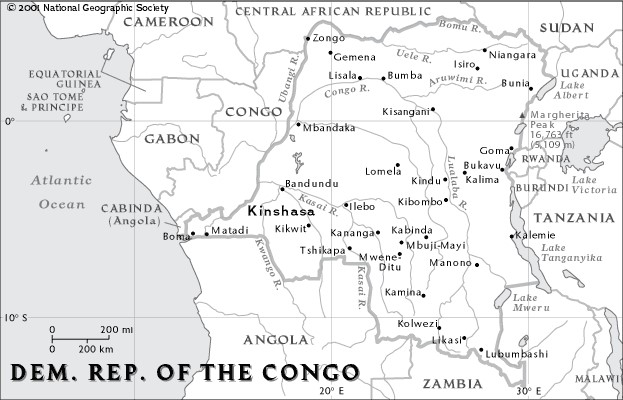
The “disappeared” of Congo-Zaire, 1996-1997. The question of the massacres of Rwandan Hutu refugees in the Democratic Republic of Congo
Marc Le Pape & Jean-Hervé Bradol
There is a new book out by Patrick de Saint-Exupéry entitled La traversée. Une odyssée au cœur de l’Afrique [The crossing. An odyssey in the heart of Africa]. What odyssey? Crossing the Congo (Zaire, later the Democratic Republic of Congo) from Rwanda. The author describes his encounters, the beers he had here and there, the bumpy rides on the back of a motorcycle (to Kisangani), a trip down the Congo River, flying over the dense forest on his way to Mbandaka.
This is not the first time he has written about the Tutsi genocide in Rwanda; he had an article in the 24 May 1994 issue of Le Figaro entitled “Les abattoirs au Rwanda” [Abattoirs in Rwanda]. Prior to that, Renaud Girard (Le Figaro), Jean-Philippe Ceppi (Libération), Annie Thomas (AFP), Philippe Gaillard (International Committee of the Red Cross), and professionals working in Rwanda, and then other journalists, had swiftly and steadfastly reported on the extermination. In May 1994, Patrick de Saint-Exupéry was conducting his own investigation of the genocide. That work helped give him great legitimacy amongst colleagues and readers when it comes to observing mass violence in Central Africa’s Great Lakes region from 1994 to the present . We read his articles in 1994 and ones that came after.

But what motivated the author to risk this odyssey and write a book? He tells us his primary objective: to call out and condemn the so-called “double genocide” (or “second genocide”) theory, which holds that there were mass killings of Rwandan Hutus in the Congo in 1996-97 – a second genocide, analogous to the 1994 genocide committed against the Tutsis in Rwanda. Now, we have always asserted that the mass crimes against Hutus in Rwanda and the Congo should not be equated with the genocide of the Tutsis living in Rwanda. As researchers and humanitarian actors, we have never expressed the slightest belief in the “double genocide” theory.
In March and April of 2021, however, we are surprised by the author’s odd way of disqualifying the double genocide theory. He is, in effect, attempting to discredit every publication and document in the past twenty-four years that has dealt with the massacres committed as Rwandan Hutus fled across the Congo in 1996-97.
We need, at this point, to explain why there were so many Rwanda Hutus in Zaire. On 4 July 1994, the Rwandan Patriotic Front (FPR) took control of Rwanda’s capital, Kigali. Since 1990, the movement had been launching armed attacks from Uganda. From its new base in Kigali, it pressed on with the war. Its advance and the collapse of the Rwandan Armed Forces (FAR) caused a massive movement to the west and then into Zaire. Enormous camps were set up not far from the Rwandan border. In March and April 1995, nine hundred thousand to a million Rwandans took refuge in North and South Kivu; numbers from the UNHCR (United Nations High Commissioner for Refugees) varied. Among those refugees were soldiers from the recently-defeated Rwandan Army, along with political and administrative leaders who had supervised the Tutsi genocide; they were mobilizing and organizing supporters who had taken part in the executions and atrocities committed from April to July 1994. Those leaders conducted a number of deadly operations inside Rwanda. The situation persisted until October 1996, at which point FPR forces, allied with Congolese rebels, conducted an operation to systematically destroy the camps. They occupied Zaire’s border region with Rwanda (North and South Kivu), causing two things to happen: a massive return of Hutu refugees to Rwanda and an equally massive flight into Zaire’s interior.
La traversée’s author asserts, in several places, that as many as 200,000 people fled: “in November 1996, Hutuland was dismantled. Seven hundred thousand Rwandans returned to the country in the space of a few days. But some remained unaccounted for; it was said that two hundred thousand of them had disappeared into the Congolese countryside. (p. 127)”. Why “it was said”? That choice of words adds credence to the argument maintained throughout the book, and is emblematic of the author’s attitude toward the data and investigations that have been available since 1997. In fact, the key international institutional actors at the time tried to establish a verifiable count based on aerial photographs, witness accounts, counts at the border, and several counts in the camps. Estimates of the number of fugitives range from 400,000 to 500,000. When a number of NGOs used the figure of 200,000 “disappeared”, it was an estimate of the number of victims of the Rwandan patriotic army.
Was there a policy of massacres? The author believes not. In 1997, however, a Rwandan officer told a mission in South Kivu that included members of MSF, the UNHCR, and the NGO CARE: “Everyone in the forest is considered the enemy” (MSF, report from the exploratory mission in South Kivu, April 1997, MSF archives). That statement was confirmed by multiple sources: survey data and counts by the UNHCR and humanitarian NGOs, information reported and summarized by IRIN (a regional newsletter published, beginning in October 1996, by the UN Office for the Coordination of Humanitarian Affairs), mission reports, MSF archives in Paris, articles in the press (particularly those in the New York Times), reports from human rights organizations like Amnesty International and Human Rights Watch, and witness accounts (from clergy members, in particular). Indeed, all of these sources attest to the fact that the organization of systematic massacres was real. We knew about them starting in 1996-97; the MSF archives confirm their existence.
After 1997 there were many articles and international academic research publications devoted to the mass violence against the refugees. Those publications and data prompted the UN High Commissioner for Human Rights to draft and publish a “Project Mapping” report on “the most serious violations of human rights and international humanitarian law” committed between 1993 and 2003 in the DRChttps://www.ohchr.org/documents/countries/cd/drc_mapping_report_final_fr.pdf. From October 2008 to May 2009, twenty or so UN investigators were in the field gathering information, documents, and witness accounts on the nature, seriousness, and number of crimes and violations committed. Part of chapter II of that report (p. 78-118 §191-268) is devoted to the “attacks against Hutu refugees”.The “Mapping” is one of the author’s main targets, due to the witness accounts and documents published in the report. He attempts to discredit them. The same goes for the massacres in the Walikale region (in December 1996, 200 kilometers from the dismantled camps), whose ferocity and cruelty the Mapping pieced together from accounts gathered by the UN Secretary-General’s Investigative Team in 1997-98 and then from interviews conducted in 2008. About them the author, who was in Walikale during his “odyssey”, wrote: “And no one is talking about it here? (p. 173)”. From that he concludes that the Mapping “was overstating the facts”, that it was instilling the image of Rwandan Patriotic Army soldiers behaving like génocidaires, in that case and in others. In fact, Saint-Exupéry claims to have identified a guiding aim in the Mapping: “to recount a war using the vocabulary of extermination. Waterloo described in the language of Auschwitz” (p. 148).
He opened up about this in a conversation with Rwandan James Kabarebe who, “very calm, very firm, very sure of himself”, replied: “It’s politics.”(p. 79) Yet James Kabarebe commanded Rwandan troops in Congo/Zaire in 1996-97, and was later the Minister of Defense in Rwanda. This affable informant was important to Saint-Exupéry, who quoted him several times without drawing any connection between the general’s war story and his past involvement in the conduct of Rwandan troops in Congo/Zaire.
Generally speaking, the author’s preferred method is to disqualify all our existing knowledge, which he counters with the few meetings he had during his “odyssey”. Note, however, that he doesn’t explicitly disparage all of the investigations and publications, because he also engages in the practice of “omission”. For example, he conveniently ignores the minutely detailed reports from Amnesty International and Human Rights Watchhttps://www.hrw.org/report/1997/10/01/what-kabila-hiding/civilian-killings-and-impunity-congo, and the massacres described by James C. McKinley, Jr. and Howard French in the New York Times from November 1996 to November 1997https://www.nytimes.com/1997/04/05/world/refugees-in-zaire-at-end-of-a-death-trek.html
“Refugees in Zaire at End of a Death Trek”, James C. McKinley Jr, Saturday, April 5, 1997
http://www.nytimes.com/1997/09/23/world/refugees-from-congo-give-vivid-accounts-of-killings.html?ref=howard_w_french_french
“Refugees From Congo Give Vivid Accounts of Killings”, Howard W. French,
Tuesday, September 23, 1997.. Other sources and data suffer the same fate.
And if these “cancellings” are not enough to convince, he blames the refugees for the executions of which they were victims: “That the rebels had killed some refugees, there was no doubt. It was a war, the refugees were armed, and they chose sides. By fighting they gave up their refugee status, they exposed their families to the threat of reprisal, and they took the risk of dying themselves” (p. 261). Three fourths of that population were Rwandan women and children – attacked and pursued over 2,000 kilometers.
To cite this content :
Marc Le Pape, Jean-Hervé Bradol, “The “disappeared” of Congo-Zaire, 1996-1997. The question of the massacres of Rwandan Hutu refugees in the Democratic Republic of Congo”, 30 mars 2021, URL : https://msf-crash.org/en/blog/disappeared-congo-zaire-1996-1997-question-massacres-rwandan-hutu-refugees-democratic-republic
If you would like to comment on this article, you can find us on social media or contact us here:
Contribute


Add new comment